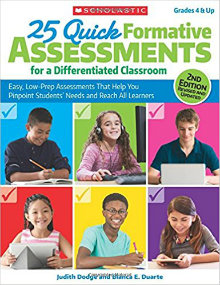25 Quick and Effective Formative Assessments
25 Quick Formative Assessments for a Differentiated Classroom
By Judith Dodge and Blanca E. Duarte
(Scholastic, 2017 – Learn more)

25 Quick Formative Assessments for a Differentiated Classroom is a truly terrific resource. I have to be honest: when I first picked it up, I thought it might not be helpful considering the fact that I have been scouring the internet for good formative assessments for more than a dozen years. However, I was very happy to find that the book was filled with new ideas and resources.
This book is divided into two sections. The first provides basic information about what formative assessments are and the second shares 25 specific assessments to use in a variety of subjects.
The Whats and Whys of Formative Assessment

The Assessments
The 25 formative assessments shared are divided into five categories:
- Summaries and Reflections
- Lists, Charts, and Graphic Organizers
- Visual Representations
- Collaborative Activities
- Self-Assessment, Peer-Assessment, and Rubrics
Each section offers three to eight easy-to-use activities that can serve as formative assessments. They call for students to write, speak, listen, draw, and act to show their understanding. Many of the assessments call for students to be active, up and out of their seats.
The strategies are thoroughly explained with an introduction, step-by-step directions, applications and extensions, information on differentiation, and a tech connection. Most also come with a template that can be immediately used by printing the online materials accessible with a code included in the book. While the strategies presented are not groundbreaking, the way they are explained and the accompanying resources make them more valuable than most I’ve encountered online.
Going Digital
What really stands out in this book is the attention the authors pay to meshing tried and true formative assessments with digital formats. Suggestions are offered for using technology to upgrade from the paper and pencil based templates. For example, the authors share ideas for using Google Forms with exit tickets, voice-to-text tools for summaries and learning logs, and my favorite, Flipgrid to allow students to record themselves as they explain their understanding.
Even more exciting, the last pages of the book are comprised of a chart that matches digital tools with each of the 25 formative assessments detailed in the previous section. This chart was informative to say the least and sparked my imagination!
25 Quick Formative Assessments for a Differentiated Classroom is a book I can recommend without reservation for teachers at all grade levels and in all content areas.
Rita Platt (@ritaplatt) is a National Board Certified teacher with master’s degrees in reading, library, and leadership. Her experience includes teaching learners in remote Alaskan villages, inner cities, and rural communities. She currently is a teacher-librarian, teaches graduate courses for the Professional Development Institute, writes for We Teach We Learn and recently launched her MiddleWeb blog, Heart of the School.


































